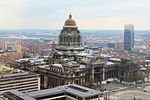Anglo-Belgian Memorial, Brussels

The Anglo-Belgian War Memorial (French: Monument Britannique, Dutch: Brits Oorlogsmonument) is a monument in Brussels, Belgium, which was commissioned by the British Imperial War Graves Commission and designed by the British sculptor Charles Sargeant Jagger (1885–1934). Unveiled in 1923 by the Prince of Wales, it commemorates the support given by the Belgian People to British prisoners of war during the First World War. It is located on the Place Poelaert/Poelaertplein near Brussels' Palace of Justice and the Belgian Infantry Memorial. The monument depicts a British and a Belgian soldier carved from Brainvilliers stone. Around the sides are reliefs showing Belgian peasants assisting wounded British soldiers. Casts of the reliefs are held at the Imperial War Museum in London, and a plaster cast of the Belgian soldier is held in the Royal Museum of the Armed Forces in Brussels .
Excerpt from the Wikipedia article Anglo-Belgian Memorial, Brussels (License: CC BY-SA 3.0, Authors, Images).Anglo-Belgian Memorial, Brussels
Place Poelaert - Poelaertplein, City of Brussels Pentagon (Brussels)
Geographical coordinates (GPS) Address External links Nearby Places Show on map
Geographical coordinates (GPS)
| Latitude | Longitude |
|---|---|
| N 50.837611 ° | E 4.353501 ° |
Address
Anglo-Belgian War Memorial
Place Poelaert - Poelaertplein
1000 City of Brussels, Pentagon (Brussels)
Belgium
Open on Google Maps









